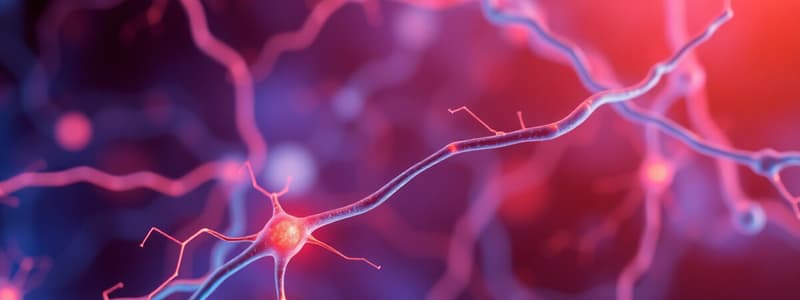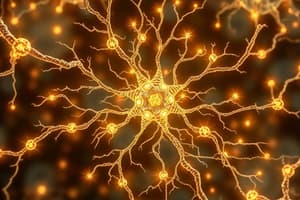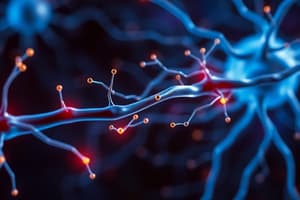Podcast
Questions and Answers
What type of muscles do autonomic motor nerves send impulses to?
What type of muscles do autonomic motor nerves send impulses to?
- Voluntary muscles
- Cardiac muscle (correct)
- Skeletal muscles
- Smooth muscle (correct)
Which ions are primarily involved in the action of the sodium-potassium pump?
Which ions are primarily involved in the action of the sodium-potassium pump?
- Calcium and chloride
- Potassium and calcium
- Magnesium and sodium
- Sodium and potassium (correct)
What occurs during depolarization of a neuron?
What occurs during depolarization of a neuron?
- Potassium ions flow into the cell
- Sodium ions flow into the cell (correct)
- Sodium ions flow out of the cell
- Calcium ions block sodium channels
What term describes the electrical difference across a neuron's membrane when it is in the resting state?
What term describes the electrical difference across a neuron's membrane when it is in the resting state?
What structure opens in response to a stimulus, allowing sodium ions to pass through the neuron's membrane?
What structure opens in response to a stimulus, allowing sodium ions to pass through the neuron's membrane?
What is the primary result of the action of the sodium-potassium pump?
What is the primary result of the action of the sodium-potassium pump?
In a resting neuron, what happens to sodium ions?
In a resting neuron, what happens to sodium ions?
What is the result of the sudden flow of sodium ions into the neuron during depolarization?
What is the result of the sudden flow of sodium ions into the neuron during depolarization?
What is the primary function of neurotransmitters in the nervous system?
What is the primary function of neurotransmitters in the nervous system?
How do hormones differ from neurotransmitters in terms of action?
How do hormones differ from neurotransmitters in terms of action?
Which two divisions make up the nervous system?
Which two divisions make up the nervous system?
What role do motor functions play in the nervous system?
What role do motor functions play in the nervous system?
What is the significance of the inability of neurons to reproduce?
What is the significance of the inability of neurons to reproduce?
Which of the following is NOT a category of functions performed by the nervous system?
Which of the following is NOT a category of functions performed by the nervous system?
What is the role of neuroglia in the nervous system?
What is the role of neuroglia in the nervous system?
What can happen to neurons during cardiac arrest?
What can happen to neurons during cardiac arrest?
What is the primary function of the neurotransmitter released by the presynaptic neuron?
What is the primary function of the neurotransmitter released by the presynaptic neuron?
Which structure at the end of the presynaptic neuron releases neurotransmitters into the synaptic cleft?
Which structure at the end of the presynaptic neuron releases neurotransmitters into the synaptic cleft?
What happens when excitatory neurotransmitters bind to their receptors on the postsynaptic membrane?
What happens when excitatory neurotransmitters bind to their receptors on the postsynaptic membrane?
What distinguishes inhibitory neurotransmitters from excitatory neurotransmitters?
What distinguishes inhibitory neurotransmitters from excitatory neurotransmitters?
What is the synaptic cleft?
What is the synaptic cleft?
How does calcium enter the presynaptic neuron during synaptic transmission?
How does calcium enter the presynaptic neuron during synaptic transmission?
Which of the following is true about acetylcholine?
Which of the following is true about acetylcholine?
Which neuron is responsible for sending the signal during synaptic transmission?
Which neuron is responsible for sending the signal during synaptic transmission?
What is the primary role of acetylcholine in the parasympathetic nervous system?
What is the primary role of acetylcholine in the parasympathetic nervous system?
Which neurotransmitter is primarily associated with the fight or flight response?
Which neurotransmitter is primarily associated with the fight or flight response?
What is the function of the cerebellum in the brain?
What is the function of the cerebellum in the brain?
Which structure is responsible for connecting the two halves of the cerebral cortex?
Which structure is responsible for connecting the two halves of the cerebral cortex?
Which of the following statements about GABA and glycine is true?
Which of the following statements about GABA and glycine is true?
What characterizes the gyri of the brain?
What characterizes the gyri of the brain?
Which part of the brain is primarily involved in higher-order behaviors such as learning and reasoning?
Which part of the brain is primarily involved in higher-order behaviors such as learning and reasoning?
What distinguishes sulci from fissures in the brain's structure?
What distinguishes sulci from fissures in the brain's structure?
What is the primary function of the thalamus in the diencephalon?
What is the primary function of the thalamus in the diencephalon?
Which cranial nerve is responsible for the sense of smell?
Which cranial nerve is responsible for the sense of smell?
Which of the following best describes the brainstem?
Which of the following best describes the brainstem?
What role does the blood-brain barrier serve?
What role does the blood-brain barrier serve?
Which cranial nerve is classified as both sensory and motor?
Which cranial nerve is classified as both sensory and motor?
What is the function of cerebrospinal fluid (CSF)?
What is the function of cerebrospinal fluid (CSF)?
Which of the following is not a layer of the meninges?
Which of the following is not a layer of the meninges?
Which cranial nerve is primarily responsible for controlling eye movements?
Which cranial nerve is primarily responsible for controlling eye movements?
What type of system is the sympathetic nervous system commonly referred to as?
What type of system is the sympathetic nervous system commonly referred to as?
Which neurotransmitter is secreted by neurons of the parasympathetic nervous system?
Which neurotransmitter is secreted by neurons of the parasympathetic nervous system?
Where are muscarinic receptors primarily located?
Where are muscarinic receptors primarily located?
Which of the following best describes autonomic reflexes?
Which of the following best describes autonomic reflexes?
What is the primary function of a sensory receptor in the reflex arc?
What is the primary function of a sensory receptor in the reflex arc?
In a withdrawal reflex, which of the following describes the pathway of sensory impulses?
In a withdrawal reflex, which of the following describes the pathway of sensory impulses?
What is the key difference between the preganglionic fibers of the parasympathetic and sympathetic nervous systems?
What is the key difference between the preganglionic fibers of the parasympathetic and sympathetic nervous systems?
Which type of reflex involves contraction of skeletal muscles?
Which type of reflex involves contraction of skeletal muscles?
Flashcards
Synapse
Synapse
The junction between two neurons or a neuron and another cell where communication occurs.
Synaptic Cleft
Synaptic Cleft
The small gap between the presynaptic and postsynaptic cells at a synapse.
Presynaptic Neuron
Presynaptic Neuron
The neuron that sends a signal and releases neurotransmitters at a synapse.
Postsynaptic Neuron
Postsynaptic Neuron
Signup and view all the flashcards
Neurotransmitter
Neurotransmitter
Signup and view all the flashcards
Excitatory Neurotransmitter
Excitatory Neurotransmitter
Signup and view all the flashcards
Inhibitory Neurotransmitter
Inhibitory Neurotransmitter
Signup and view all the flashcards
Acetylcholine
Acetylcholine
Signup and view all the flashcards
Resting State of a Neuron
Resting State of a Neuron
Signup and view all the flashcards
Sodium-Potassium Pump
Sodium-Potassium Pump
Signup and view all the flashcards
Polarized Membrane
Polarized Membrane
Signup and view all the flashcards
Resting Membrane Potential
Resting Membrane Potential
Signup and view all the flashcards
Depolarization
Depolarization
Signup and view all the flashcards
Sodium Channels
Sodium Channels
Signup and view all the flashcards
Passive Diffusion
Passive Diffusion
Signup and view all the flashcards
Action Potential
Action Potential
Signup and view all the flashcards
Parasympathetic Nerve Effect on Heart
Parasympathetic Nerve Effect on Heart
Signup and view all the flashcards
Catecholamines
Catecholamines
Signup and view all the flashcards
Norepinephrine's Role
Norepinephrine's Role
Signup and view all the flashcards
Epinephrine's Role
Epinephrine's Role
Signup and view all the flashcards
Acetylcholine Breakdown
Acetylcholine Breakdown
Signup and view all the flashcards
Brain Division
Brain Division
Signup and view all the flashcards
Cerebrum Structure
Cerebrum Structure
Signup and view all the flashcards
Cerebellum Function
Cerebellum Function
Signup and view all the flashcards
Diencephalon
Diencephalon
Signup and view all the flashcards
Hypothalamus
Hypothalamus
Signup and view all the flashcards
Pituitary Gland
Pituitary Gland
Signup and view all the flashcards
Brainstem
Brainstem
Signup and view all the flashcards
Meninges
Meninges
Signup and view all the flashcards
Cerebrospinal Fluid (CSF)
Cerebrospinal Fluid (CSF)
Signup and view all the flashcards
Blood-Brain Barrier
Blood-Brain Barrier
Signup and view all the flashcards
Cranial Nerves
Cranial Nerves
Signup and view all the flashcards
Sensory Neuron
Sensory Neuron
Signup and view all the flashcards
Motor Neuron
Motor Neuron
Signup and view all the flashcards
Sympathetic Nervous System
Sympathetic Nervous System
Signup and view all the flashcards
Parasympathetic Nervous System
Parasympathetic Nervous System
Signup and view all the flashcards
Reflex
Reflex
Signup and view all the flashcards
Somatic Reflex
Somatic Reflex
Signup and view all the flashcards
Autonomic Reflex
Autonomic Reflex
Signup and view all the flashcards
Muscle Spindle
Muscle Spindle
Signup and view all the flashcards
What are the two main communication systems in the body?
What are the two main communication systems in the body?
Signup and view all the flashcards
What are neurotransmitters?
What are neurotransmitters?
Signup and view all the flashcards
How do neurotransmitters and hormones differ in speed and duration?
How do neurotransmitters and hormones differ in speed and duration?
Signup and view all the flashcards
What are the two main divisions of the nervous system?
What are the two main divisions of the nervous system?
Signup and view all the flashcards
What does the central nervous system (CNS) consist of?
What does the central nervous system (CNS) consist of?
Signup and view all the flashcards
What are the three main functions of the nervous system?
What are the three main functions of the nervous system?
Signup and view all the flashcards
What are neurons and what makes them unique?
What are neurons and what makes them unique?
Signup and view all the flashcards
What are glial cells and what is their function?
What are glial cells and what is their function?
Signup and view all the flashcards
Study Notes
Body Communication Systems
- The body has two main communication systems: the nervous system and the endocrine system.
- The nervous system uses chemical messengers called neurotransmitters, which are produced by neurons (nerve cells).
- Neurotransmitters travel across synapses (spaces between nerve cells) quickly.
- The endocrine system uses hormones, which travel through the bloodstream.
- Hormones have a slower response than neurotransmitters but can sustain activity longer.
Nervous System Divisions
- The nervous system has two main divisions: central nervous system (CNS) and peripheral nervous system (PNS).
- The CNS is made up of the brain and spinal cord.
- The PNS connects the CNS to the rest of the body.
Nervous System Functions
- Sensory functions: gather information from inside and outside the body.
- Integrating functions: process the sensory information.
- Motor functions: respond to the integrated information, causing an action.
Neurons
- Neurons are the basic units of the nervous system.
- Neurons cannot reproduce, so damage is irreversible unless the cell body is intact.
- Neurons need oxygen to survive.
- They respond to stimuli and transmit impulses between parts of the body.
- Neurons cannot live without oxygen.
Neuroglia (Glial Cells)
- Neuroglia (glial cells) support and protect neurons.
- They do not transmit impulses, but aid in structure and protection.
Neuron Structure
- Neurons have a cell body (soma).
- Dendrites receive signals, and axons send signals.
- Axons are sometimes covered with myelin sheaths.
- Myelin sheath is made of glial cells called oligodendrocytes (in brain and spinal cord) and Schwann cells (outside brain and spinal cord).
- Myelin speeds up nerve impulses. Gaps in the myelin sheath (nodes of Ranvier) facilitate faster impulse transmission.
Central Nervous System (CNS) and Peripheral Nervous System (PNS)
- The CNS includes the brain and spinal cord.
- The PNS consists of nerves that carry information to and from the CNS.
Nervous System Component Functions
- Cranial nerves: nerves that emerge from the brain.
- Spinal nerves: nerves that emerge from the spinal cord.
- Nerves containing both sensory and motor fibers are called mixed nerves.
- Afferent fibers conduct sensory impulses to the CNS.
- Efferent fibers conduct impulses away from the CNS.
Synaptic Transmission
- The synapse is a junction between two neurons or a neuron and another tissue.
- Presynaptic neuron releases neurotransmitters across the synaptic cleft.
- Postsynaptic neuron receives the neurotransmitters, triggering an impulse.
- Neurotransmitters are released by the presynaptic neuron into the synaptic cleft.
- The postsynaptic neuron contains receptors for these neurotransmitters.
- The combination of neurotransmitter receptors and neurotransmitter triggers a change in either the postsynaptic cell membrane potential or enzyme activity.
- The speed of signal transmission between the synapse is determined by the type of neurotransmitter released and the type of receptors present on the postsynaptic membrane.
Types of Neurotransmitters
- Acetylcholine: involved in muscle contraction and can be excitatory or inhibitory.
- Norepinephrine: plays a role in the "fight-or-flight" response.
- Dopamine: involved in movement and pleasure.
- Epinephrine: involved in the "fight-or-flight" response.
- GABA and glycine have inhibitory effects.
Reflexes
- Reflexes are automatic responses to stimuli.
- Some reflexes involve the spinal cord, while others involve the brain.
- The pupillary light reflex (PLR) is an example of an autonomic reflex.
Studying That Suits You
Use AI to generate personalized quizzes and flashcards to suit your learning preferences.




